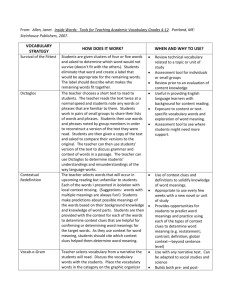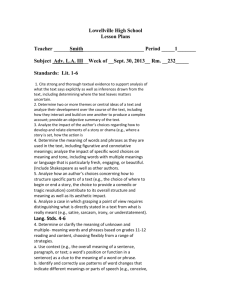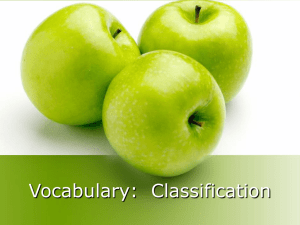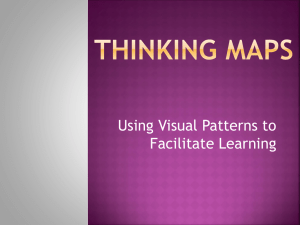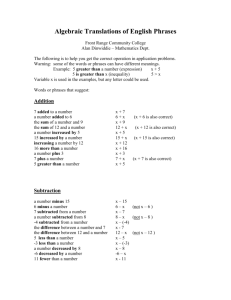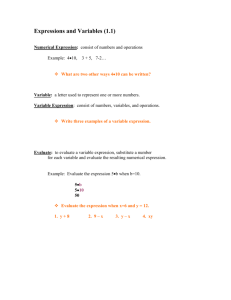Standard Knowledge Reasoning Performance Skill Product 1
advertisement
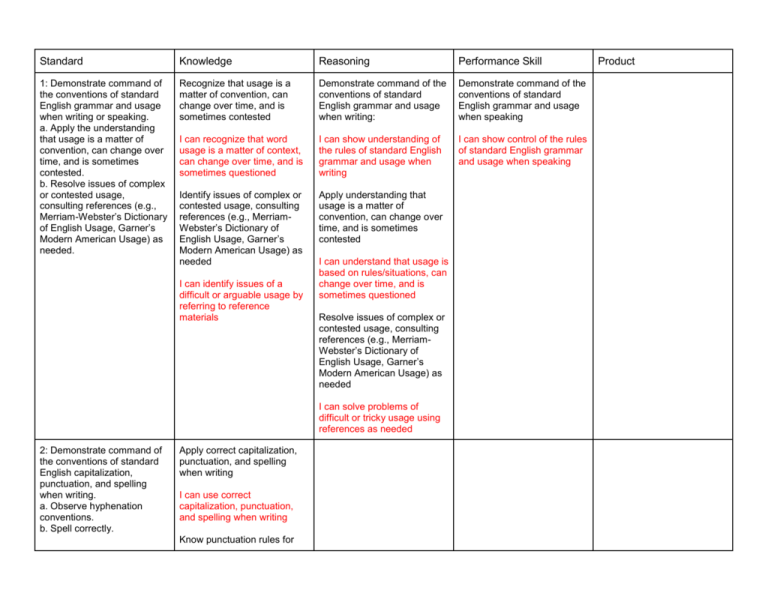
Standard Knowledge Reasoning Performance Skill 1: Demonstrate command of the conventions of standard English grammar and usage when writing or speaking. a. Apply the understanding that usage is a matter of convention, can change over time, and is sometimes contested. b. Resolve issues of complex or contested usage, consulting references (e.g., Merriam-Webster’s Dictionary of English Usage, Garner’s Modern American Usage) as needed. Recognize that usage is a matter of convention, can change over time, and is sometimes contested Demonstrate command of the conventions of standard English grammar and usage when writing: Demonstrate command of the conventions of standard English grammar and usage when speaking I can recognize that word usage is a matter of context, can change over time, and is sometimes questioned I can show understanding of the rules of standard English grammar and usage when writing I can show control of the rules of standard English grammar and usage when speaking Identify issues of complex or contested usage, consulting references (e.g., MerriamWebster’s Dictionary of English Usage, Garner’s Modern American Usage) as needed Apply understanding that usage is a matter of convention, can change over time, and is sometimes contested I can identify issues of a difficult or arguable usage by referring to reference materials I can understand that usage is based on rules/situations, can change over time, and is sometimes questioned Resolve issues of complex or contested usage, consulting references (e.g., MerriamWebster’s Dictionary of English Usage, Garner’s Modern American Usage) as needed I can solve problems of difficult or tricky usage using references as needed 2: Demonstrate command of the conventions of standard English capitalization, punctuation, and spelling when writing. a. Observe hyphenation conventions. b. Spell correctly. Apply correct capitalization, punctuation, and spelling when writing I can use correct capitalization, punctuation, and spelling when writing Know punctuation rules for Product hyphen usage I know punctuation rules for hyphen usage Use hyphens in phrases and clauses I can use hyphens in phrases and clauses Recall and apply spelling rules I can recall and apply spelling rules Identify and correct misspelled words I can identify and correct misspelled words 3: Apply knowledge of language to understand how language functions in different contexts, to make effective choices for meaning or style, and to comprehend more fully when reading or listening. a. Vary syntax for effect, consulting references (e.g., Tufte’s Artful Sentences) for guidance as needed; apply an understanding of syntax to the study of complex texts when reading. Understand how language functions in different contexts I can understand how language works in different situations Understand: - style - syntax I can understand style/author technique and word arrangement/sentence structure Apply knowledge of language: - to determine how language functions in different contexts - to make effective choices for meaning or style - to comprehend more fully when reading or listening I can use knowledge of language to: - decide how language works in different situations - make effective choices for meaning or style - better understand when reading/listening Vary syntax for effect when writing, consulting references when needed I can change word arrangement/sentence structure for effect when writing using references when needed Apply knowledge of syntax to the study of complex texts when reading I can apply what I know about word arrangement/sentence structure to the study of difficult texts when reading 4: Standard: Determine or clarify the meaning of unknown and multiplemeaning words and phrases based on grades 11-12 reading and content, choosing flexibly from a range of strategies. a. Use context (e.g., the overall meaning of a sentence, paragraph, or text; a word’s position or function in a sentence) as a clue to the meaning of a word or phrase. b. Identify and correctly use patterns of word changes that indicate different meanings or parts of speech (e.g., conceive, conception, conceivable). c. Consult general and specialized reference materials (e.g., dictionaries, glossaries, thesauruses), both print and digital, to find the pronunciation of a word or determine or clarify its precise meaning, its part of speech, its etymology, or its standard usage. d. Verify the preliminary Recognize context clues (e.g., the overall meaning of a sentence, paragraph, or text; a word’s position or function in a sentence) I can recognize context clues to determine the overall meaning of a sentence, paragraph or text; a word’s position or function in a sentence Identify words and phrases that have multiple meanings I can identify words and phrases that have multiple meanings Recognize patterns of word changes that indicate meaning or part of speech (e.g., conceive, conception, conceivable) I can recognize word patterns that indicate parts of speech Consult specialized and general print and digital Use context (e.g., the overall meaning of a sentence, paragraph, or text; a word’s position or function in a sentence) as a clue to the meaning of a multiple meaning or unknown word or phrase I can use context as a clue to the meanings of unknown words or phrases Use patterns of word changes to determine meaning (e.g., conceive, conception, conceivable) I can use word patterns to determine meanings of unknown words Choose flexibly from a range of vocabulary strategies to determine or clarify the meaning of an unknown or multiple-meaning word or phrase I can employ various determination of the meaning of a word or phrase (e.g., by checking the inferred meaning in context or in a dictionary). reference materials to find: - word pronunciation - meaning - part of speech - etymology - standard usage I can use various print and digital materials to find word pronunciation, meaning, part of speech, etymology (history of the word), and standard usage 5: Demonstrate understanding of figurative language, word relationships, and nuances in word meanings. a. Interpret figures of speech (e.g. hyperbole, paradox) in context and analyze their role in text. b. Analyze nuances in the meaning of words with similar denotations. vocabulary strategies to determine the meanings of words Verify preliminary determination of the meaning of a word or phrase I can confirm my predictions of word meanings Define figures of speech (e.g. hyperbole, paradox) Interpret figures of speech (e.g. hyperbole, paradox) I can define figures of speech (non-literal use of language) I can interpret figures of speech Recognize figures of speech within the text Analyze the role of figurative language within the text I can find examples of figures of speech (non-literal use of language) within the text I can examine the use of and reasons for figurative/nonliteral language within a text Identify words with similar denotations Determine how figurative language impacts a text’s purpose I can identify words with similar literal/dictionary meanings Recognize nuances in the meaning of words with similar meanings I can find small differences in the meaning of similar words I can decide how figurative/non-literal language impacts the purpose of a text Analyze nuances in the meanings of words with similar denotations I can break down and study small differences in the meanings of words with similar literal/dictionary meanings 6: Acquire and use accurately general academic and domain -specific words and phrases sufficient for reading, writing, speaking and listening at the college and career readiness level; demonstrate independence in gathering vocabulary knowledge when considering a word or phrase important to comprehension or expression. Identify academic and domain-specific words and phrases sufficient for: - reading - writing - speaking and listening I can identify situationally/ environmentally appropriate words or phrases in reading, writing, speaking, and listening Recognize and gather words and phrases important to comprehension or expression Make meaning and use accurately words and phrases important to the comprehension of academic and domain-specific words through: - reading - writing - speaking and listening I can use situationally/ environmentally appropriate words or phrases in reading, writing, speaking, and listening Use general academic and domain-specific words and phrases at the college and career readiness level, sufficient for: - reading - writing - speaking and listening I can use situationally/ environmentally appropriate words or phrases in reading, writing, speaking, and listening Use appropriate contextual clues when demonstrating independence in gathering vocabulary knowledge I can recognize and gather words and phrases important to comprehension or expression Acquire and use appropriate contextual clues when demonstrating independence in gathering vocabulary knowledge Identify appropriate resources to aid in gathering vocabulary knowledge I can independently gather vocabulary knowledge through context clues I can identify appropriate resources to aid in gathering vocabulary knowledge Select appropriate resources to aid in gathering vocabulary knowledge Demonstrate independence in gathering vocabulary knowledge by: - contextual clues - references/resource I can select appropriate resources to aid in gathering vocabulary knowledge I can select appropriate resources to aid in gathering vocabulary knowledge I can independently gather vocabulary knowledge through context clues
